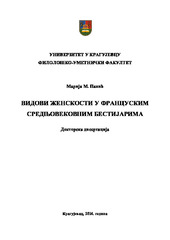Приказ основних података о дисертацији
Vidovi ženskosti u francuskim srednjovekovnim bestijarima
Aspects of Femininity in French Medieval Bestiaries
| dc.contributor.advisor | Melić, Katarina | |
| dc.contributor.other | Novaković, Jelena | |
| dc.contributor.other | Tešanović, Biljana | |
| dc.creator | Panić, Marija M. | |
| dc.date.accessioned | 2018-12-27T12:17:31Z | |
| dc.date.available | 2018-12-27T12:17:31Z | |
| dc.date.available | 2020-07-03T15:24:11Z | |
| dc.date.issued | 2014-10-29 | |
| dc.identifier.uri | https://nardus.mpn.gov.rs/handle/123456789/10530 | |
| dc.identifier.uri | http://eteze.kg.ac.rs/application/showtheses?thesesId=5851 | |
| dc.identifier.uri | https://fedorakg.kg.ac.rs/fedora/get/o:984/bdef:Content/download | |
| dc.description.abstract | his thesis examines the representation of femininity in six French medieval bestiaries (Philippe de Phaon: Bestiaire, Gervaise: Bestiaire, Guillaume de Normandie: Bestiaire divin, Pierre de Beauvais: Bestiaire, Richard de Fournival: Bestiaire d’amour, pseudo-Pierre de Beauvais: Bestiaire) written in the 12th and the 13th centuries. In the Middle Ages the sexual difference was thought to have the essential influence on character and behaviour. Feminine beings were defined in comparison with masculine beings, they were and less valued and represented as inferior. French bestiaries examined in the thesis have the characteristics of medieval didactic literature (which have the sources in the naturalist texts of Antiquity and late Antiquity), religious and courtly tradition. By analysing the topics containing characteristics of femininity in the naturalist parts of the bestiary chapters (maternity, sexual difference, partnership and the representation of an independent feminine individual), we have concluded that the representation of female individuals contains socially constructed gender stereotypes, that the female individual is represented in implicit comparison with the male individual (which has a higher valorisation) and that there is metaphorical usage of femininity as a negative valorisation. The interpretative parts of bestiary chapters of traditional bestiaries (Philippe de Thaon, Gervaise, Guillaume of Normandy, Pierre de Beauvais, pseudo-Pierre de Beauvais) don‟t make a difference between male and female recipients and dont‟t systematically criticize females as inferior beings, however they introduce traditional misogynist characterization of females (lust, greed, duplicity). Eve and Virgin Mary are present as biblical female characters, even though there is no direct relation between them and women. The courtly interpretation of bestiary of Richard de Fournival contains the characterisation of female nature which has the characteristics traditionally attributed to women (talkativeness, duplicity, superficiality, instability). In this bestiary we have found that the nature of ideal love is described through the representation of motherly love towards the young, which we have named the female paradigm of love. The social and historical context of the feudal society can partly be constructed from the bestiaries dedicated to women. We have concluded that at all the levels of the analysis femininity is represented with misogyny, in comparison with masculine identity and less valued, which was a general opinion in the Middle Ages. From this point of view there is no difference between the traditional bestiaries, which interpret the universe symbolically, and the courtly bestiary influenced by Aristotelian naturalism. | en |
| dc.format | application/pdf | |
| dc.language | sr | |
| dc.publisher | Универзитет у Крагујевцу, Филолошко-уметнички факултет | sr |
| dc.rights | openAccess | en |
| dc.rights.uri | https://creativecommons.org/licenses/by-nc-nd/4.0/ | |
| dc.source | Универзитет у Крагујевцу | sr |
| dc.subject | bestijar | sr |
| dc.subject | ženskost | sr |
| dc.subject | alegorija | sr |
| dc.subject | životinja | sr |
| dc.subject | francuska književnost | sr |
| dc.subject | francuska književnost srednjeg veka | sr |
| dc.subject | didaktička književnost | sr |
| dc.title | Vidovi ženskosti u francuskim srednjovekovnim bestijarima | sr |
| dc.title.alternative | Aspects of Femininity in French Medieval Bestiaries | en |
| dc.type | doctoralThesis | en |
| dc.rights.license | BY-NC-ND | |
| dc.identifier.fulltext | https://nardus.mpn.gov.rs/bitstream/id/50964/Disertacija.pdf | |
| dc.identifier.fulltext | http://nardus.mpn.gov.rs/bitstream/id/50964/Disertacija.pdf | |
| dc.identifier.rcub | https://hdl.handle.net/21.15107/rcub_nardus_10530 |


